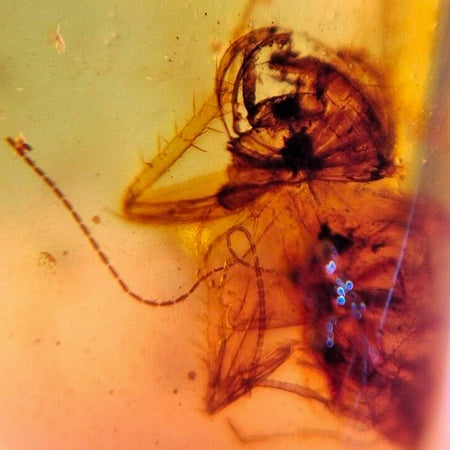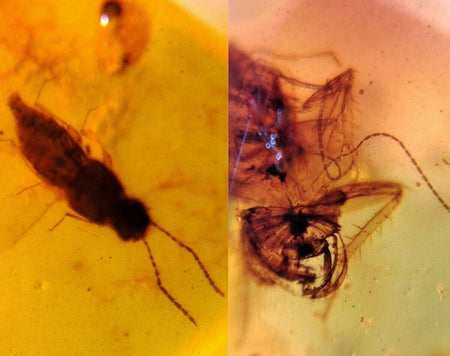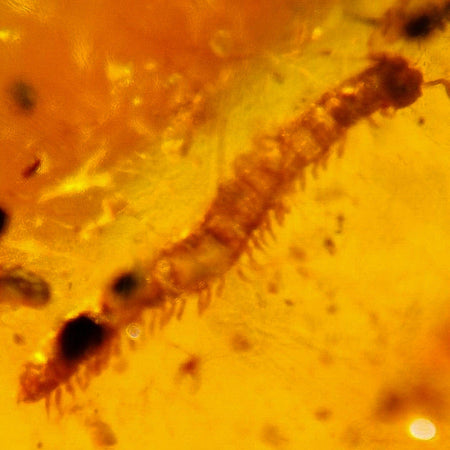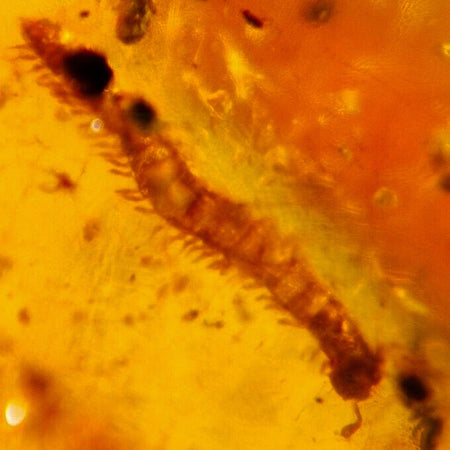Burmese Insect Amber
Burmese Amber, also known as Burmite or Kachin amber, is amber from the Hukawng Valley in northern Myanmar. The amber is dated to around 99 million years old, during the earliest part of the Cenomanian age of the Late Cretaceous.
Amber is a resin material that is formed from fossilized conifer tree sap during years of constant pressure and heat. This yellow to reddish-brown translucent material has been used in a number of ways, including making jewelry, in Egyptian burials, and in the healing arts. Amber also plays an invaluable role in research. In some cases, amber contains inclusions, such as insects, whole or parts of animals, and plants that are trapped and preserved. The ability to hold a piece of history untouched by time has resulted in a number of scientific discoveries and advances such as feathers on a non-avian dinosaur dated 145 million years ago and the biosynthesis of gene clusters for novel antibiotics.
What Is Burmese Amber and Its Place of Origin?
Burmese Amber, also known as Burmite or Kachin amber, is amber from the Hukawng Valley in northern Myanmar. The amber is dated to around 99 million years old, during the earliest part of the Cenomanian age of the Late Cretaceous.
Amber is a resin material formed from fossilized conifer tree sap under years of constant pressure and heat. This yellow to reddish-brown translucent material has been used in several ways, including making jewelry, in Egyptian burials, and in the healing arts.
Amber also plays an invaluable role in research. In some cases, amber contains inclusions, such as insects, whole or parts of animals, and trapped and preserved plants. The ability to hold a piece of history untouched by time has resulted in several scientific discoveries and advances, such as feathers on a dinosaur dated 145 million years ago and the biosynthesis of gene clusters for unexplored antibiotics.
How Old Is Burmese Amber and Why Does Its Age Matter?
Since Burmese amber is one of the oldest deposits with well-preserved inclusions, its age matters. Most other amber deposits formed during the Eocene or Miocene, while Burmese amber represents life from 100 million years ago. This is important because this period in Earth's history has often been preserved in the fossil record. At this time, insects were diversifying, flowering plants were evolving, and various significant evolutionary events were in full force.
Analyzing Burmese amber enables researchers to look into organisms and ecological relationships that existed long before many of today's species showed up, thus exposing the mechanism of evolution that shaped the current natural world.
How Does Tree Resin Turn Into Amber?
Amber is formed from a sticky resin produced by conifers. Over time, the resin drips or oozes down many surfaces, trapping tiny organisms like insects, spiders, and bits of plants. Upon burial, a resin undergoes polymerization, a gradual process whereby heat and pressure transform it from a soft and sticky matter into a hard fossilized material.
The transformation of resin takes millions of years. This is how we gain access today to a very durable translucent form known as amber. Burmese amber's yellow to red-brown colors result from its unique chemical composition and the environmental conditions experienced during its fossilization.
What Organisms Are Found in Burmese Amber?
The extraordinary inclusions of Burmese amber range from evidence of life of the Cretaceous, such as ants, beetles, wasps, and flies, to arachnids such as spiders and mites. Also included are some pollen and various plant materials, including leaves and seeds. Occasionally, small portions of lizards or amphibians can be found.
What makes the inclusions extra special is that they were preserved well, so much so that sometimes even microscopic details, such as features of wing veins or details of the bodies of insects, are well-maintained. Such excellent preservation gives us an unusual insight into the ancient ecosystems, presenting a spectacular view of life that existed 100 million years ago.
Why Are Inclusions So Important to Science?
The Burmese amber inclusions are of immense value to science because they allow the direct study of ancient organisms in remarkable detail. They shed light on species diversity in the Middle Cretaceous, including species completely new to science. Through these fossils, scientists can trace the evolutionary changes, like how ants and wasps began, and their ecological roles within ecosystems.
The inclusions even contain information on behavior, such as predation or mating, and reveal clues about the ways these organisms lived and interacted. In addition to being a physical record, amber serves as a means of viewing extinct organisms' biological and ecological processes.
How Has Burmese Amber Affected Our View of Evolution?
Discoveries about Burmese amber have changed much about evolution. For instance, feathers on a non-avian dinosaur were probably preserved in amber, proving that feathers existed before birds learned to fly. This, therefore, falsified the previous theory about the origin of feathers and connected dinosaurs closer to modern birds.
Other discoveries in Burmese amber revealed some primitive forms of ants and wasps that bear evidence of early social behavior and have been instrumental in tracing their ancient evolutionary history. Even the discoveries of minute fungi and microbes preserved in amber have helped to shed light on ancient ecosystems and the complex interactions of organisms that paved the way for life millions of years ago.
Can We Extract Genetic Information from Amber?
Extracting DNA from an amber fossil has mesmerized scientists and the public. However, DNA declines with time, and the chance of finding an intact genetic material inside amber is extremely rare. Yet remarkably, Burmese amber has preserved the biochemical compounds and fragments of genetic materials, enabling researchers to identify gene clusters that contribute to making natural antibiotics. This shows a surprising and promising side of amber in present medical research development, which can pave the way for finding new medicines based on ancient biological processes.
How Do Scientists Authenticate Burmese Amber?
Due to its scientific importance and commercial appeal, genuine Burmese amber authentication is important since synthetics or artificially treated models can create confusion. Various methods through which experts authenticate the amber include observing the fluorescence of industry-grown amber under ultraviolet light, as genuine amber usually shows a characteristic glow.
The second test is that the amber can be dropped in salt water: real amber floats while fake ones will not. Another few tests include chemical spectroscopy alongside microscopic analysis of the composition and structure of amber. The study of the inclusions also helps, since natural specimens have irregular and complicated shapes quite different from those of manufactured imitations.
Why Do Burmese Ambers Come at a Higher Price?
Being involved in trade has made Burmese amber extra valuable for several reasons. First comes an extraordinary factor, as it is one of the Amber deposits, aged almost a hundred million years ago. The second comes from the diversity and quality of its inclusions, which are amazing, including species not found in any other deposit. Scientific interest in these fossils raises their value even further, as their contribution to evolutionary biology and palaeontology is immense.
How Has Burmese Amber Been Used Throughout History?
Amber has always fascinated humans, and Burmese amber is not an exception. Historically, amber has been valued for its beauty and used for jewelry and ornamental arts. Cultures such as the Egyptians considered amber in their burial rites and regarded it as protection.
Many people attributed some healing and spirituality powers to amber and thus incorporated it into their systems of traditional medicine and rituals. Today, Burmese amber is still cherished for its beauty and scientific importance, bridging art, culture, and natural history.
How to Care for and Store Burmese Amber?
Despite its hardness, amber is an organic material that needs careful handling. Exposed to heat, sunlight, and harsh chemicals, amber can discolor, become brittle, or lose its shine. Cleaning of amber should be gentle, using a soft cloth with mild soap and avoiding abrasive cleaners that may scratch its surface.
Amber should be stored away from direct sunlight, extreme temperatures to prevent degradation, thus maintaining its natural beauty and the visibility of the fascinating inclusions inside. This care will allow the Burmese amber to remain a treasured piece for many generations.
Why It Should Be Considered for Your Collection
Burmese amber is indeed one fine and irreplaceable example of nature's artistry. It is a memory for collectors and scientists, returning them to ecosystems about 100 million years ago. Beyond the scientific importance, the Burmese amber is a beautiful natural artwork with stunning inclusions. Whether the reference is for history, artistry, or research, Burmese amber will grow in any collection and will always be a subject to further appreciation.





